ATC code none PubChem CID 6089 Formula C12H16N2 Boiling point 160 °C Density 1.099 g/cm³ | CAS Number 61-50-7 IUPHAR/BPS 141 Molar mass 188.269 g/mol CAS ID 61-50-7 | |
 | ||
Routes ofadministration Oral (with an MAOI), insufflated, rectal, vaporized, IM, IV Legal status AU: S9 (Prohibited)CA: Schedule IIIDE: Anlage I (Controlled)UK: Controlled Drug LicUS: Schedule I | ||
N,N-Dimethyltryptamine (DMT or N,N-DMT) is a powerful psychedelic compound of the tryptamine family. It is a structural analog of serotonin and melatonin and a functional analog of other psychedelic tryptamines such as 4-AcO-DMT, 5-MeO-DMT, 5-HO-DMT, psilocybin (4-PO-DMT), and psilocin (4-HO-DMT).
Contents
- Dependence liability
- Physical
- Consciousness
- Machine Elves
- As distinguished from 5 MeO DMT
- Pharmacokinetics
- Pharmacodynamics
- Inhalation
- Injection
- Oral ingestion
- Chemistry
- Biosynthesis
- Evidence in mammals
- Detection in body fluids
- Conjecture
- Usage
- History
- International law
- Australia
- Canada
- France
- The Netherlands
- New Zealand
- Russia
- United Kingdom
- United States
- References

Historically, it has been consumed by indigenous Amazonian cultures in the form of ayahuasca for divinatory and healing purposes. It was first synthesised in 1931, and in 1946, microbiologist Oswaldo Gonçalves de Lima discovered its natural presence in plants. In the 1960s, it was detected in mammalian organisms as well.
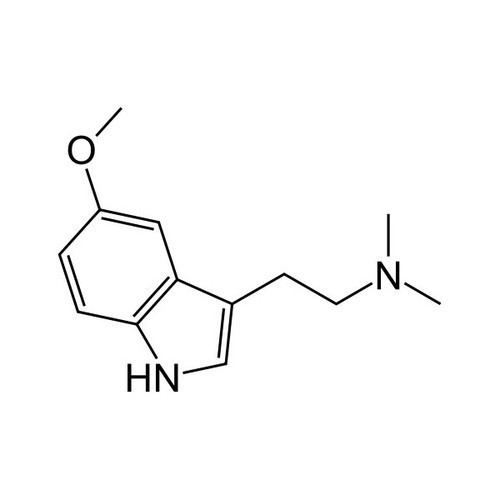
DMT is known for its relatively short duration of action, intense effects and rapid onset. For that reason, DMT was known as a "businessman's trip" during the 1960s in the United States.
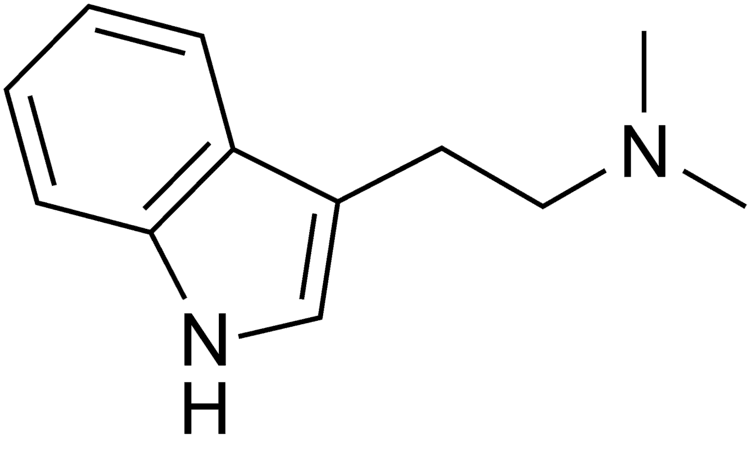
DMT can be inhaled, injected, or orally ingested, and its effects depend on the dose, both of DMT and of any MAOI taken with it. The effects last a short period of time, 5 to 15 min. Longer effects can be achieved by oral ingestion: over 3 hours. DMT can produce psychedelic experiences involving euphoria and hallucinations. In most countries, DMT is illegal.
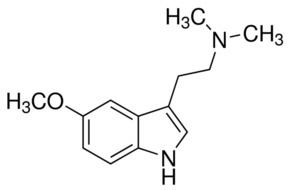
Dependence liability

The dependence potential of DMT and the risk of sustained psychological disturbance are minimal when used for religious ceremonies. DMT, like most psychedelics, is considered to be neither addictive, nor toxic, although there is a rare chance some might develop a psychological dependence.
Physical
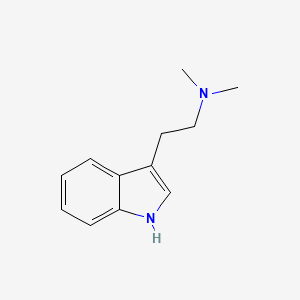
According to a dose-response study, "dimethyltryptamine dose slightly elevated blood pressure, heart rate, pupil diameter, and rectal temperature, in addition to elevating blood concentrations of beta-endorphin, corticotropin, cortisol, and prolactin. Growth hormone blood levels rose equally in response to all doses of DMT, and melatonin levels were unaffected."
Consciousness
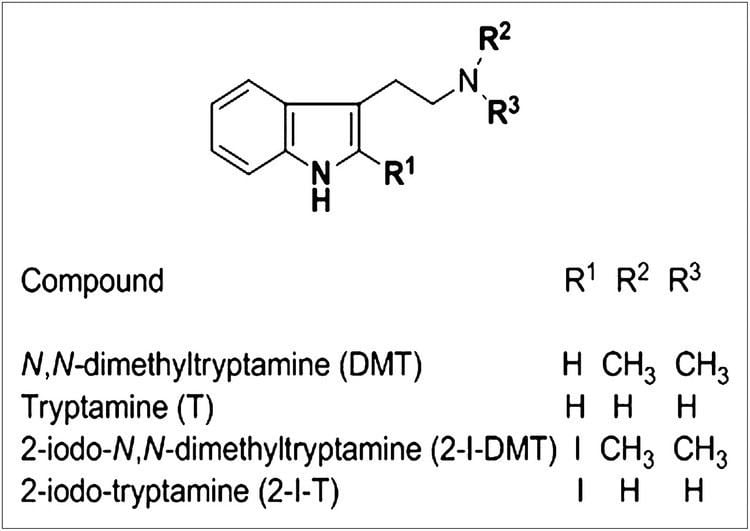
Several scientific experimental studies have tried to measure subjective experiences of altered states of consciousness induced by drugs. Here it is important to notice that in scientific studies measurements are conducted in laboratories under highly controlled and safe conditions. It appears that the set and setting have a strong influence, therefore if the drug is taken in different settings, its induced effects might in part strongly differ from the laboratory situation.
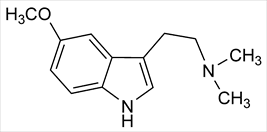
In the 1990s, Strassman and his colleagues conducted a five year long DMT study at the University of New Mexico. The results provided insight about the quality of subjective psychedelic experiences. In this study participants received the DMT dosage intravenously via injection and the findings suggested that different psychedelic experiences can occur, depending on the level of dosage. Lower doses (0.1 and 0.05 mg/kg, read "mg DMT per kg body weight") produced somaesthetic and emotional responses, but not hallucinogenic experiences (e.g., 0.05 mg/kg had mild mood elevating and calming properties). In contrary, higher doses (0.2. and 0.4 mg/kg) researchers labeled as "hallucinogenic" that elicited "intensely colored, rapidly moving display of visual images, formed, abstract or both". Comparing to other sensory modalities the most affected was visual domain. Participants reported visual hallucinations, less auditory hallucinations and specific physical sensation progressing to a sense of bodily dissociation, as well as experiences of euphoria, calm, fear, and anxiety.
Strassman also stressed the importance of the context where drug has been taken. He claimed that DMT has no beneficial effects of itself, rather the context when and where people take it plays an important role.
It appears that DMT can produce a hallucinogenic experience. It can induce a state or feeling to a person that she or he is able to "communicate with other intelligent-life forms" (see "Machine Elves"). High doses of DMT produce a hallucinatory state that involves sense of "another intelligence" that people sometimes describe as "super-intelligent", but "emotionally detached".
In 1995 Adolf Dittrich and Daniel Lamparter did a study where they found that DMT induced altered state of consciousness (ASC) is strongly influenced by habitual, rather than situative factors. In the study researchers used three dimensions of the APZ questionnaire to describe ASC (rating scales of ASC). First, oceanic boundlessness (OB) refers to dissolution of ego boundaries mostly associated with positive emotions. Second, anxious ego-dissolution (AED) includes disorder of thoughts, loss of autonomy and self-control and third, visionary restructuralization (VR) that includes auditory and visual illusions, hallucinations. Results showed strong effects within first and third dimensions for all conditions, especially DMT and suggested strong intrastability of elicited reactions independently of the condition for the OB and VR scales. Importantly, the experiment was conducted in a safe laboratory environment. This particular setting had a certain influence on found results that might be very different outside the laboratory environment.
"Machine Elves"
The term Machine Elf was coined by ethnobotanist Terence McKenna for the experience, who also used the terms fractal elves, or self-transforming machine elves.
Hallucinations of strange creatures had been reported by Szara in the Journal of Mental Science (now the British Journal of Psychiatry) (1958) "Dimethyltryptamine Experiments with Psychotics", Stephen Szara described how one of his subjects under the influence of DMT had experienced "strange creatures, dwarves or something" at the beginning of a DMT trip.
Other researchers of the experience described 'entities' or 'beings' in humanoid as well as animal form, with descriptions of "little people" being common (non-human gnomes, elves, imps etc.). This form of hallucination has been speculated to be the cause of alien abduction experiences through endogenously occurring DMT.
Cliff Pickover has also written about the "machine elf"-experience, in the book Sex, Drugs, Einstein, & Elves.
As distinguished from 5-MeO-DMT
5-MeO-DMT, a psychedelic drug structurally similar to N,N-DMT, is sometimes referred to as DMT through abbreviation. As a white, crystalline solid, it is also similar in appearance to DMT. However, it is considerably more potent (5-MeO-DMT typical vaporized dose: 5–20 mg).
Pharmacokinetics
DMT peak level concentrations (Cmax) measured in whole blood after intramuscular (IM) injection (0.7 mg/kg, n = 11) and in plasma following intravenous (IV) administration (0.4 mg/kg, n = 10) of fully psychedelic doses are in the range of ≈14 to 154 μg/L and 32 to 204 μg/L, respectively. The corresponding molar concentrations of DMT are therefore in the range of 0.074–0.818 µM in whole blood and 0.170–1.08 µM in plasma. However, several studies have described active transport and accumulation of DMT into rat and dog brain following peripheral administration. Similar active transport, and accumulation processes likely occur in human brain and may concentrate DMT in brain by several-fold or more (relatively to blood), resulting in local concentrations in the micromolar or higher range. Such concentrations would be commensurate with serotonin brain tissue concentrations, which have been consistently determined to be in the 1.5-4 μM range.
Closely coextending with peak psychedelic effects, mean time to reach peak concentrations (Tmax) was determined to be 10–15 minutes in whole blood after IM injection, and 2 minutes in plasma after IV administration. When taken orally mixed in an ayahuasca decoction, and in freeze-dried ayahuasca gel caps, DMT Tmax is considerably delayed: 107.59 ± 32.5 minutes, and 90–120 minutes, respectively. The pharmacokinetics for vaporizing DMT have not been studied or reported.
Pharmacodynamics
DMT binds non-selectively with affinities < 0.6 μM to the following serotonin receptors: 5-HT1A, 5-HT1B, 5-HT1D, 5-HT2A, 5-HT2B, 5-HT2C, 5-HT6, and 5-HT7. An agonist action has been determined at 5-HT1A, 5-HT2A and 5-HT2C. Its efficacies at other serotonin receptors remain to be determined. Of special interest will be the determination of its efficacy at human 5-HT2B receptor as two in vitro assays evidenced DMT's high affinity for this receptor: 0.108 μM and 0.184 μM. This may be of importance because chronic or frequent uses of serotonergic drugs showing preferential high affinity and clear agonism at 5-HT2B receptor have been causally linked to valvular heart disease.
It has also been shown to possess affinity for the dopamine D1, α1-adrenergic, α2-adrenergic, imidazoline-1, and sigma-1 (σ1) receptors. Converging lines of evidence established activation of the σ1 receptor at concentrations of 50–100 μM. Its efficacies at the other receptor binding sites are unclear. It has also been shown in vitro to be a substrate for the cell-surface serotonin transporter (SERT) and the intracellular vesicular monoamine transporter 2 (VMAT2), inhibiting SERT-mediated serotonin uptake in human platelets at an average concentration of 4.00 ± 0.70 μM and VMAT2-mediated serotonin uptake in vesicles (of army worm Sf9 cells) expressing rat VMAT2 at an average concentration of 93 ± 6.8 μM.
As with other so-called "classical hallucinogens", a large part of DMT psychedelic effects can be attributed to a functionally selective activation of the 5-HT2A receptor. DMT concentrations eliciting 50% of its maximal effect (half maximal effective concentration = EC50 or Kact) at the human 5-HT2A receptor in vitro are in the 0.118–0.983 μM range. This range of values coincides well with the range of concentrations measured in blood and plasma after administration of a fully psychedelic dose (see Pharmacokinetics).
As DMT has been shown to have slightly better efficacy (EC50) at human serotonin 2C receptor than at the 2A receptor, 5-HT2C is also likely implicated in DMT's overall effects. Other receptors, such as 5-HT1A σ1, may also play a role.
In 2009, it was hypothesized that DMT may be an endogenous ligand for the σ1 receptor. The concentration of DMT needed for σ1 activation in vitro (50–100 μM) is similar to the behaviorally active concentration measured in mouse brain of approximately 106 μM This is minimally 4 orders of magnitude higher than the average concentrations measured in rat brain tissue or human plasma under basal conditions (see Endogenous DMT), so σ1 receptors are likely to be activated only under conditions of high local DMT concentrations. If DMT is stored in synaptic vesicles, such concentrations might occur during vesicular release. To illustrate, while the average concentration of serotonin in brain tissue is in the 1.5-4 μM range, the concentration of serotonin in synaptic vesicles was measured at 270 mM. Following vesicular release, the resulting concentration of serotonin in the synaptic cleft, to which serotonin receptors are exposed, is estimated to be about 300 μM. Thus, while in vitro receptor binding affinities, efficacies, and average concentrations in tissue or plasma are useful, they are not likely to predict DMT concentrations in the vesicles or at synaptic or intracellular receptors. Under these conditions, notions of receptor selectivity are moot, and it seems probable that most of the receptors identified as targets for DMT (see above) participate in producing its psychedelic effects.
Inhalation
A standard dose for vaporized DMT is 15–60 mg. In general, this is inhaled in a few successive breaths. The effects last for a short period of time, usually 5 to 15 minutes, dependent on the dose. The onset after inhalation is very fast (less than 45 seconds) and peak effects are reached within a minute. In the 1960s, DMT was known as a "businessman's trip" in the US because of the relatively short duration (and rapid onset) of action when inhaled.
Injection
Injected DMT produces an experience that is similar to inhalation in duration, intensity, and characteristics.
In a study conducted from 1990 through 1995, University of New Mexico psychiatrist Rick Strassman found that some volunteers injected with high doses of DMT reported experiences with perceived alien entities. Usually, the reported entities were experienced as the inhabitants of a perceived independent reality the subjects reported visiting while under the influence of DMT. In a September 2009 interview, Strassman described the effects on participants in the study. He stated that "subjectively, the most interesting results were that high doses of DMT seemed to allow the consciousness of our volunteers to enter into non-corporeal, free-standing, independent realms of existence inhabited by beings of light who oftentimes were expecting the volunteers, and with whom the volunteers interacted. While 'typical' near-death and mystical states occurred, they were relatively rare."
Oral ingestion
DMT is broken down by the enzyme monoamine oxidase through a process called deamination, and is quickly inactivated orally unless combined with a monoamine oxidase inhibitor (MAOI). The traditional South American beverage ayahuasca, or yage, is derived by boiling the ayahuasca vine (Banisteriopsis caapi) with leaves of one or more plants containing DMT, such as Psychotria viridis, Psychotria carthagenensis, or Diplopterys cabrerana. The Ayahuasca vine contains harmala alkaloids, highly active reversible inihibitors of monoamine oxidase A (RIMAs), rendering the DMT orally active by protecting it from deamination. A variety of different recipes are used to make the brew depending on the purpose of the ayahuasca session, or local availability of ingredients. Two common sources of DMT in the western US are reed canary grass (Phalaris arundinacea) and Harding grass (Phalaris aquatica). These invasive grasses contain low levels of DMT and other alkaloids. In addition, Jurema (Mimosa tenuiflora) shows evidence of DMT content: the pink layer in the inner rootbark of this small tree contains a high concentration of N,N-DMT.
Taken orally with an RIMA, DMT produces a long lasting (over 3 hour), slow, deep metaphysical experience similar to that of psilocybin mushrooms, but more intense. RIMAs should be used with caution as they can have lethal interactions with some prescription drugs such as SSRI antidepressants, and some over-the-counter drugs.
Induced DMT experiences can include profound time-dilation, visual and auditory illusions, and other experiences that, by most firsthand accounts, defy verbal or visual description. Some users report intense erotic imagery and sensations and utilize the drug in a ritual sexual context.
Chemistry
DMT is commonly handled and stored as a fumarate, as other DMT acid salts are extremely hygroscopic and will not readily crystallize. Its freebase form, although less stable than DMT fumarate, is favored by recreational users choosing to vaporize the chemical as it has a lower boiling point. In contrast to DMT's base, its salts are water-soluble. DMT in solution degrades relatively quickly and should be stored protected from air, light, and heat in a freezer.
Biosynthesis
Dimethyltryptamine is an indole alkaloid derived from the shikimate pathway. Its biosynthesis is relatively simple and summarized in the adjacent picture. In plants, the parent amino acid L-tryptophan is produced endogenously where in animals L-tryptophan is an essential amino acid coming from diet. No matter the source of L-tryptophan, the biosynthesis begins with its decarboxylation by an aromatic amino acid decarboxylase (AADC) enzyme (step 1). The resulting decarboxylated tryptophan analog is tryptamine. Tryptamine then undergoes a transmethylation (step 2): the enzyme indolethylamine-N-methyltransferase (INMT) catalyzes the transfer of a methyl group from cofactor S-adenosyl-methionine (SAM), via nucleophilic attack, to tryptamine. This reaction transforms SAM into S-adenosylhomocysteine (SAH), and gives the intermediate product N-methyltryptamine (NMT). NMT is in turn transmethylated by the same process (step 3) to form the end product N,N-dimethyltryptamine. Tryptamine transmethylation is regulated by two products of the reaction: SAH, and DMT were shown ex vivo to be among the most potent inhibitors of rabbit INMT activity.
This transmethylation mechanism has been repeatedly and consistently proven by radiolabeling of SAM methyl group with carbon-14 (14C-CH3)SAM).
Evidence in mammals
Published in Science in 1961, Julius Axelrod found an N-methyltransferase enzyme capable of mediating biotransformation of tryptamine into DMT in a rabbit's lung. This finding initiated a still ongoing scientific interest in endogenous DMT production in humans and other mammals. From then on, two major complementary lines of evidence have been investigated: localization and further characterization of the N-methyltransferase enzyme, and analytical studies looking for endogenously produced DMT in body fluids and tissues.
In 2013 researchers first reported DMT in the pineal gland microdialysate of rodents.
A study published in 2014 reported the biosynthesis of N,N-dimethyltryptamine (DMT) in the human melanoma cell line SK-Mel-147 including details on its metabolism by peroxidases.
In a 2014 paper a group first demonstrated the immunomodulatory potential of DMT and 5-MeO-DMT through the Sigma-1 receptor of human immune cells. This immunomodulatory activity may contribute to significant anti-inflammatory effects and tissue regeneration.
INMT
Before techniques of molecular biology were used to localize indolethylamine N-methyltransferase (INMT), characterization and localization went on a par: samples of the biological material where INMT is hypothesized to be active are subject to enzyme assay. Those enzyme assays are performed either with a radiolabeled methyl donor like (14C-CH3)SAM to which known amounts of unlabeled substrates like tryptamine are added or with addition of a radiolabeled substrate like (14C)NMT to demonstrate in vivo formation. As qualitative determination of the radioactively tagged product of the enzymatic reaction is sufficient to characterize INMT existence and activity (or lack of), analytical methods used in INMT assays are not required to be as sensitive as those needed to directly detect and quantify the minute amounts of endogenously formed DMT (see DMT subsection below). The essentially qualitative method thin layer chromatography (TLC) was thus used in a vast majority of studies. Also, robust evidence that INMT can catalyze transmethylation of tryptamine into NMT and DMT could be provided with reverse isotope dilution analysis coupled to mass spectrometry for rabbit and human lung during the early 1970s.
Selectivity rather than sensitivity proved to be an Achilles’ heel for some TLC methods with the discovery in 1974–1975 that incubating rat blood cells or brain tissue with (14C-CH3)SAM and NMT as substrate mostly yields tetrahydro-β-carboline derivatives, and negligible amounts of DMT in brain tissue. It is indeed simultaneously realized that the TLC methods used thus far in almost all published studies on INMT and DMT biosynthesis are incapable to resolve DMT from those tetrahydro-β-carbolines. These findings are a blow for all previous claims of evidence of INMT activity and DMT biosynthesis in avian and mammalian brain, including in vivo, as they all relied upon use of the problematic TLC methods: their validity is doubted in replication studies that make use of improved TLC methods, and fail to evidence DMT-producing INMT activity in rat and human brain tissues. Published in 1978, the last study attempting to evidence in vivo INMT activity and DMT production in brain (rat) with TLC methods finds biotransformation of radiolabeled tryptamine into DMT to be real but "insignificant". Capability of the method used in this latter study to resolve DMT from tetrahydro-β-carbolines is questioned later.
To localize INMT, a qualitative leap is accomplished with use of modern techniques of molecular biology, and of immunohistochemistry. In humans, a gene encoding INMT is determined to be located on chromosome 7. Northern blot analyses reveal INMT messenger RNA (mRNA) to be highly expressed in rabbit lung, and in human thyroid, adrenal gland, and lung. Intermediate levels of expression are found in human heart, skeletal muscle, trachea, stomach, small intestine, pancreas, testis, prostate, placenta, lymph node, and spinal cord. Low to very low levels of expression are noted in rabbit brain, and human thymus, liver, spleen, kidney, colon, ovary, and bone marrow. INMT mRNA expression is absent in human peripheral blood leukocytes, whole brain, and in tissue from 7 specific brain regions (thalamus, subthalamic nucleus, caudate nucleus, hippocampus, amygdala, substantia nigra, and corpus callosum). Immunohistochemistry showed INMT to be present in large amounts in glandular epithelial cells of small and large intestines. In 2011, immunohistochemistry revealed the presence of INMT in primate nervous tissue including retina, spinal cord motor neurons, and pineal gland.
Endogenous DMT
The first claimed detection of mammalian endogenous DMT was published in June 1965: German researchers F. Franzen and H. Gross report to have evidenced and quantified DMT, along with its structural analog bufotenin (5-HO-DMT), in human blood and urine. In an article published four months later, the method used in their study was strongly criticized, and the credibility of their results challenged.
Few of the analytical methods used prior to 2001 to measure levels of endogenously formed DMT had enough sensitivity and selectivity to produce reliable results. Gas chromatography, preferably coupled to mass spectrometry (GC-MS), is considered a minimum requirement. A study published in 2005 implements the most sensitive and selective method ever used to measure endogenous DMT: liquid chromatography-tandem mass spectrometry with electrospray ionization (LC-ESI-MS/MS) allows for reaching limits of detection (LODs) 12 to 200 fold lower than those attained by the best methods employed in the 1970s. The data summarized in the table below are from studies conforming to the abovementioned requirements (abbreviations used: CSF = cerebrospinal fluid; LOD = limit of detection; n = number of samples; ng/L and ng/kg = nanograms (10−9 g) per litre, and nanograms per kilogram, respectively):
A 2013 study found DMT in microdialysate obtained from a rat's pineal gland, providing evidence of endogenous DMT in the mammalian brain.
Detection in body fluids
DMT may be measured in blood, plasma or urine using chromatographic techniques as a diagnostic tool in clinical poisoning situations or to aid in the medicolegal investigation of suspicious deaths. In general, blood or plasma DMT levels in recreational users of the drug are in the 10–30 μg/L range during the first several hours post-ingestion. Less than 0.1% of an oral dose is eliminated unchanged in the 24-hour urine of humans.
Conjecture
In the 1950s, the endogenous production of psychoactive agents was considered to be a potential explanation for the hallucinatory symptoms of some psychiatric diseases; this is known as the transmethylation hypothesis. Several speculative and yet untested hypotheses suggest that endogenous DMT is produced in the human brain and is involved in certain psychological and neurological states. DMT is naturally occurring in small amounts in rat brain, human cerebrospinal fluid, and other tissues of humans and other mammals. A biochemical mechanism for this was proposed by the medical researcher J. C. Callaway, who suggested in 1988 that DMT might be connected with visual dream phenomena: brain DMT levels would be periodically elevated to induce visual dreaming and possibly other natural states of mind. A role of endogenous hallucinogens including DMT in higher level sensory processing and awareness was proposed by J. V. Wallach (2009) based on a hypothetical role of DMT as a neurotransmitter. In 2011, Nicholas V. Cozzi, of the University of Wisconsin School of Medicine and Public Health, concluded that INMT, an enzyme that may be associated with the biosynthesis of DMT and endogenous hallucinogens, is present in the primate (rhesus macaque) pineal gland, retinal ganglion neurons, and spinal cord. Neurobiologist Andrew Gallimore (2013) suggested that while DMT might not have a modern neural function, it may have been an ancestral neuromodulator once secreted in psychedelic concentrations during REM sleep, a function now lost.
Usage
DMT is produced in many species of plants often in conjunction with its close chemical relatives 5-MeO-DMT and bufotenin (5-OH-DMT). DMT-containing plants are commonly used in South American shamanic practices. It is usually one of the main active constituents of the drink ayahuasca; however, ayahuasca is sometimes brewed with plants that do not produce DMT. It occurs as the primary psychoactive alkaloid in several plants including Mimosa tenuiflora, Diplopterys cabrerana, and Psychotria viridis. DMT is found as a minor alkaloid in snuff made from Virola bark resin in which 5-MeO-DMT is the main active alkaloid. DMT is also found as a minor alkaloid in bark, pods, and beans of Anadenanthera peregrina and Anadenanthera colubrina used to make Yopo and Vilca snuff in which bufotenin is the main active alkaloid. Psilocin, an active chemical in many psychedelic mushrooms, is structurally similar to DMT.
The psychotropic effects of DMT were first studied scientifically by the Hungarian chemist and psychologist Dr. Stephen Szára, who performed research with volunteers in the mid-1950s. Szára, who later worked for the US National Institutes of Health, had turned his attention to DMT after his order for LSD from the Swiss company Sandoz Laboratories was rejected on the grounds that the powerful psychotropic could be dangerous in the hands of a communist country.
DMT is generally not active orally unless it is combined with a monoamine oxidase inhibitor (MAOI) such as a reversible inhibitor of monoamine oxidase A (RIMA), for example, harmaline. Without an MAOI, the body quickly metabolizes orally administered DMT, and it therefore has no hallucinogenic effect unless the dose exceeds monoamine oxidase's metabolic capacity. Other means of ingestion such as vaporizing, injecting, or insufflating the drug can produce powerful hallucinations for a short time (usually less than half an hour), as the DMT reaches the brain before it can be metabolized by the body's natural monoamine oxidase. Taking a MAOI prior to vaporizing or injecting DMT prolongs and potentiates the effects.
History
DMT was first synthesized in 1931 by Canadian chemist Richard Helmuth Fredrick Manske (1901–1977). In general, its discovery as a natural product is credited to Brazilian chemist and microbiologist Oswaldo Gonçalves de Lima (1908–1989) who, in 1946, isolated an alkaloid he named nigerina (nigerine) from the root bark of jurema preta, that is, Mimosa tenuiflora. However, in a careful review of the case Jonathan Ott shows that the empirical formula for nigerine determined by Gonçalves de Lima, which notably contains an atom of oxygen, can match only a partial, "impure" or "contaminated" form of DMT. It was only in 1959, when Gonçalves de Lima provided American chemists a sample of Mimosa tenuiflora roots, that DMT was unequivocally identified in this plant material. Less ambiguous is the case of isolation and formal identification of DMT in 1955 in seeds and pods of Anadenanthera peregrina by a team of American chemists led by Evan Horning (1916–1993). Since 1955, DMT has been found in a host of organisms: in at least fifty plant species belonging to ten families, and in at least four animal species, including one gorgonian and three mammalian species.
Another historical milestone is the discovery of DMT in plants frequently used by Amazonian natives as additive to the vine Banisteriopsis caapi to make ayahuasca decoctions. In 1957, American chemists Francis Hochstein and Anita Paradies identified DMT in an "aqueous extract" of leaves of a plant they named Prestonia amazonicum (sic) and described as "commonly mixed" with B. caapi. The lack of a proper botanical identification of Prestonia amazonica in this study led American ethnobotanist Richard Evans Schultes (1915–2001) and other scientists to raise serious doubts about the claimed plant identity. Better evidence was produced in 1965 by French pharmacologist Jacques Poisson, who isolated DMT as a sole alkaloid from leaves, provided and used by Aguaruna Indians, identified as having come from the vine Diplopterys cabrerana (then known as Banisteriopsis rusbyana). Published in 1970, the first identification of DMT in the plant Psychotria viridis, another common additive of ayahuasca, was made by a team of American researchers led by pharmacologist Ara der Marderosian. Not only did they detect DMT in leaves of P. viridis obtained from Cashinahua Indians, but they also were the first to identify it in a sample of an ayahuasca decoction, prepared by the same Indians.
International law
DMT is classified as a Schedule I drug under the UN 1971 Convention on Psychotropic Substances, meaning that international trade in DMT is supposed to be closely monitored; use of DMT is supposed to be restricted to scientific research and medical use. Natural materials containing DMT, including ayahuasca, are not regulated under the 1971 Psychotropic Convention.
Australia
Between 2011 and 2012, the Australian Federal Government was considering changes to the Australian Criminal Code that would classify any plants containing any amount of DMT as "controlled plants". DMT itself was already controlled under current laws. The proposed changes included other similar blanket bans for other substances, such as a ban on any and all plants containing Mescaline or Ephedrine. The proposal was not pursued after political embarrassment on realisation that this would make the official Floral Emblem of Australia, Acacia pycnantha (Golden Wattle), illegal. The Therapeutic Goods Administration and federal authority had considered a motion to ban the same, but this was withdrawn in May 2012 (as DMT may still hold potential entheogenic value to native and/or religious people).
DMT is listed as a Schedule 9 prohibited substance in Australia under the Poisons Standard (October 2015). A schedule 9 drug is outlined in the Poisons Act 1964 as "Substances which may be abused or misused, the manufacture, possession, sale or use of which should be prohibited by law except when required for medical or scientific research, or for analytical, teaching or training purposes with approval of the CEO."
Under the Misuse of Drugs act 1981 6.0g of DMT is considered enough to determine a court of trial and 2.0g is considered intent to sell and supply.
Canada
DMT is classified in Canada as a Schedule III drug under the Controlled Drugs and Substances Act.
France
DMT, along with most of its plant sources, is classified in France as a stupéfiant (narcotic).
The Netherlands
The drug is banned in the Netherlands and is on list 1 of the Opium Act. Producing, trading or possession of DMT is prohibited.
New Zealand
DMT is classified in New Zealand as a Class A drug under the Misuse of Drugs Act 1975.
Russia
Classified as a Schedule I narcotic.
United Kingdom
DMT is classified in the United Kingdom as a Class A drug.
United States
DMT is classified in the United States as a Schedule I drug under the Controlled Substances Act of 1970.
In December 2004, the Supreme Court lifted a stay, thereby allowing the Brazil-based União do Vegetal (UDV) church to use a decoction containing DMT in their Christmas services that year. This decoction is a tea made from boiled leaves and vines, known as hoasca within the UDV, and ayahuasca in different cultures. In Gonzales v. O Centro Espirita Beneficente Uniao do Vegetal, the Supreme Court heard arguments on November 1, 2005, and unanimously ruled in February 2006 that the U.S. federal government must allow the UDV to import and consume the tea for religious ceremonies under the 1993 Religious Freedom Restoration Act.
In September 2008, the three Santo Daime churches filed suit in federal court to gain legal status to import DMT-containing ayahuasca tea. The case, Church of the Holy Light of the Queen v. Mukasey, presided over by Judge Owen M. Panner, was ruled in favor of the Santo Daime church. As of March 21, 2009, a federal judge says members of the church in Ashland can import, distribute and brew ayahuasca. U.S. District Judge Owen Panner issued a permanent injunction barring the government from prohibiting or penalizing the sacramental use of "Daime tea". Panner's order said activities of The Church of the Holy Light of the Queen are legal and protected under freedom of religion. His order prohibits the federal government from interfering with and prosecuting church members who follow a list of regulations set out in his order.
